Primary Pyrrolimines and Pyridinimines
Abstract
:1. Introduction
2. Results
2.1. N-H-Unsubstituted Pyrrolimines and Pyridinimines
2.1.1. Selected Imines
2.1.2. Synthesis of the α-Aminonitriles 3a–3d and 4a–4f
2.1.3. Synthesis of the N-Allylamines 5a–5d and 6a–6f
2.1.4. Synthesis of and Attempts to Synthesize the Imines 1a–1d and 2a–2f
2.2. Reactions of Transimination
2.3. Synthesis of Complexed Imines
3. Discussion
4. Materials and Methods








Supplementary Materials
Author Contributions
Funding
Institutional Review Board Statement
Informed Consent Statement
Data Availability Statement
Acknowledgments
Conflicts of Interest
References
- Braillon, B.; Lasne, M.-C.; Ripoll, J.-L.; Denis, J.M. Methanimine. Nouv. J. Chim. 1982, 6, 121–122. [Google Scholar]
- Guillemin, J.-C.; Denis, J.-M. Vacuum dynamic gas-phase/solid-phase reactions: N-chlorination of primary amines and the α-elimination of the resulting chloramines: Access to reactive (E)- and (Z)-alkanimines. Angew. Chem. Int. Ed. 1982, 21, 690. [Google Scholar] [CrossRef]
- Bock, H.; Dammel, R. Gas-phase reactions. 66. Gas-phase pyrolyses of alkyl azides: Experimental evidence for chemical activation. J. Am. Chem. Soc. 1988, 110, 5261–5269. [Google Scholar] [CrossRef]
- Ying, L.; Xia, Y.; Shang, H.; Zhao, X.; Tang, Y. Photodissociation of methylazide: Observation of triplet methylnitrene radical. J. Chem. Phys. 1996, 105, 5798–5805. [Google Scholar] [CrossRef]
- Guillemin, J.-C.; Denis, J.-M. Synthèse d’imines linéaires non-stabilisées par réactions gaz-solide sous vide (1). Tetrahedron 1988, 44, 4431–4446. [Google Scholar] [CrossRef]
- Earl, R.A.; Vollhardt, K.P.C. On the synthetic utility of thermally generated imines: The retro-ene imino Diels-Alder reaction. Heterocycles 1982, 19, 265–271. [Google Scholar] [CrossRef]
- Bizzocchi, L.; Prudenzano, D.; Rivilla, V.M.; Pietropolli-Charmet, A.; Giuliano, B.M.; Caselli, P.; Martín-Pintado, J.; Jiménez-Serra, I.; Martín, S.; Requena-Torres, M.A.; et al. Propargylimine in the laboratory and in space: Millimetre-wave spectroscopy and first detection in the ISM. Astron. Astrophys. 2020, 640, A98. [Google Scholar] [CrossRef]
- Godfrey, P.D.; Brown, R.D.; Robinson, B.J.; Sinclair, M.W. Discovery of Interstellar Methanimine (Formaldimine). Astrophys. J. Lett. 1973, 13, 119. [Google Scholar]
- Loomis, R.A.; Zaleski, D.P.; Steber, A.L.; Neill, J.L.; Muckle, M.T.; Harris, B.J.; Hollis, J.M.; Jewell, P.R.; Lattanzi, V.; Lovas, F.J.; et al. The detection of interstellar ethanimine (CH3CHNH) from observations taken during the gbt primos survey. Astrophys. J. Lett. 2013, 765, L9. [Google Scholar] [CrossRef]
- Zaleski, D.P.; Seifert, N.A.; Steber, A.L.; Muckle, M.T.; Loomis, R.A.; Corby, J.F.; Martinez, O.; Crabtree, K.N.; Jewell, P.R.; Hollis, J.M.; et al. Detection of E-cyanomethanimine toward Sagittarius B2(N) in the green bank Telescope primos survey. Astrophys. J. Lett. 2013, 765, L10. [Google Scholar] [CrossRef]
- Rivilla, V.M.; Martın-Pintado, J.; Jimenez-Serra, I.; Zeng, S.; Martın, S.; Armijos-Abendano, J.; Requena-Torres, M.A.; Aladro, R.; Riquelme, D. Abundant Z-cyanomethanimine in the interstellar medium: Paving the way to the synthesis of adenine. Month. Not. R. Astron. Soc. Lett. 2019, 483, L114–L119. [Google Scholar] [CrossRef]
- San Andrés, D.; Rivilla, V.M.; Colzi, L.; Jiménez-Serra, I.; Martín-Pintado, J.; Megías, A.; López-Gallifa, Á.; Martínez-Henares, A.; Massalkhi, S.; Zeng, S.; et al. First detection in space of the high-energy isomer of cyanomethanimine: H2CNCN. Astrophys. J. 2024, 967, 39. [Google Scholar] [CrossRef]
- Drabkin, V.D.; Paczelt, V.; Eckhardt, A.K. Spectroscopic identification of interstellar relevant 2-iminoacetaldehyde. Chem. Commun. 2023, 59, 12715–12718. [Google Scholar] [CrossRef] [PubMed]
- Eckhardt, A.K. Spectroscopic evidence for 1,2-diiminoethane a key intermediate in imidazole synthesis. Chem. Commun. 2022, 58, 8484–8487. [Google Scholar] [CrossRef]
- Chataigner, I.; Pauzat, F.; Tasseau, O.; Ellinger, Y.; Guillemin, J.-C. Thermodynamical stability of [CNN and NCN] sequences as indication of most abundant structures in the ISM. Astron. Astrophys. 2024, 689, A118. [Google Scholar] [CrossRef]
- Ayachi, H.; Gazzeh, H.; Boubaker, T.; Guillemin, J.-C. Methylenecyanamide (CH2═NCN) and (Z)- and (E)-Iminoacetonitriles (NC–CH═NH), Dimers of Hydrogen Cyanide. J. Org. Chem. 2023, 88, 2570–2574. [Google Scholar] [CrossRef]
- Kpoezoun, A.; Gazzeh, H.; Baba, G.; Guillemin, J.-C. Synthesis and Characterization of N-Unsubstituted 2- and 3-Furanimines. J. Org. Chem. 2024, 89, 11026–11030. [Google Scholar] [CrossRef]
- Kpoezoun, A.; Baba, G.; Guillemin, J.-C. N-Unsubstituted 2- and 3-thiophenimines. Org. Biomol. Chem. 2024, 22, 8505–8510. [Google Scholar] [CrossRef]
- Levien, T.L.; Baker, D.E. Remdesivir. Hosp. Pharm. 2023, 58, 420–430. [Google Scholar] [CrossRef]
- Jeelan Basha, N.; Basavarajaiah, S.M.; Shyamsunder, K. Therapeutic potential of pyrrole and pyrrolidine analogs: An update. Mol. Divers. 2022, 26, 2915–2937. [Google Scholar] [CrossRef]
- Haynes, S.W.; Sydor, P.K.; Corre, C.; Song, L.; Challis, G.L. Stereochemical Elucidation of Streptorubin B. J. Am. Chem. Soc. 2011, 133, 1793–1798. [Google Scholar] [CrossRef] [PubMed]
- Aleem, A.; Kothadia, J.P. Remdesivir. In StatPearls; StatPearls Publishing: Treasure Island, FL, USA, 2022. [Google Scholar] [PubMed]
- Bakheit, A.H.; Darwish, H.; Darwish, I.A.; Al-Ghusn, A.I. Chapter Three—Remdesivir. In ProPiles of Drug Substances, Excipients and Related Methodology; Al-Majed, A.A., Ed.; Academic Press: Cambridge, MA, USA, 2023; Volume 48, pp. 71–108. [Google Scholar]
- Al-TawPiq, J.A.; Al-Homoud, A.H.; Memish, Z.A. Remdesivir as a possible therapeutic option for the COVID-19. Travel Med. Infect. Dis. 2020, 34, 101615. [Google Scholar] [CrossRef]
- Lamb, Y.N. Remdesivir: First Approval. Drugs 2020, 80, 1355–1363. [Google Scholar] [CrossRef] [PubMed]
- Beigel, J.H.; Tomashek, K.M.; Dodd, L.E.; Mehta, A.K.; Zingman, B.S.; Kalil, A.C.; Hohmann, E. Remdesivir for the Treatment of Covid-19—Preliminary Report. N. Engl. J. Med. 2020, 383, 1813–1826. [Google Scholar] [CrossRef] [PubMed]
- Nhean, S.; Varela, M.E.; Nguyen, Y.N.; Juarez, A.; Huynh, T.; Udeh, D.; Tseng, A.L. COVID-19: A Review of Potential Treatments (Corticosteroids, Remdesivir, Tocilizumab, Bamlanivimab/Etesevimab, and Casirivimab/Imdevimab) and Pharmacological Considerations. J. Pharm. Pract. 2023, 36, 407–417. [Google Scholar] [CrossRef]
- Müller-Lissner, S.A.; Fumagalli, I.; Bardhan, K.D.; Pace, F.; Pecher, E.; Nault, B.; Rüegg, P. Tegaserod, a 5-HT4 receptor partial agonist, relieves symptoms in irritable bowel syndrome patients with abdominal pain, bloating and constipation. Aliment. Pharmacol. Ther. 2001, 15, 1655–1666. [Google Scholar] [CrossRef]
- Shah, E.D.; Lacy, B.E.; Chey, W.D.; Chang, L.; Brenner, D.M. Tegaserod for Irritable Bowel Syndrome With Constipation in Women Younger Than 65 Years Without Cardiovascular Disease: Pooled Analyses of 4 Controlled Trials. Am. J. Gastroenterol. 2021, 116, 1601–1611. [Google Scholar] [CrossRef]
- Lee, E.Y.; Caffrey, A.R. Thrombocytopenia with Tedizolid and Linezolid. Antimicrob. Agents Chemother. 2017, 62, 10–1128. [Google Scholar] [CrossRef]
- Fischer, J.; Ganellin, C.R. Analogue-Based Drug Discovery; John Wiley & Sons: Hoboken, NJ, USA, 2006; p. 53. ISBN 9783527607495. [Google Scholar]
- Bourbon, P.; Puig, P. 2-Pyridyl ketimines. Compt. Rend. 1964, 258, 3323–3326. [Google Scholar]
- Wakchaure, V.N.; List, B. Catalytic Asymmetric Reductive Condensation of N–H Imines: Synthesis of C2-Symmetric Secondary Amines. Angew. Chem. Int. Ed. 2016, 55, 15775–15778. [Google Scholar] [CrossRef]
- Vu, T.Y.; Chrostowska, A.; Huynh, T.K.X.; Khayar, S.; Dargelos, A.; Justyna, K.; Pasternak, B.; Lesniak, S.; Wentrup, C. New Reactions of N-tert-Butylimines; Formation of N-Heterocycles by Methyl Radical Elimination on Flash Vacuum Thermolysis of N-Benzylidene- and N-(2-Pyridyl-methylidene)-tert-butylamines. Chem. Eur. J. 2013, 19, 14983–14988. [Google Scholar] [CrossRef] [PubMed]
- Preparation and Formulation of Pyrazolylcarboxamides as Agrochemical Fungicides. Patent DE3713774 A1, 29 October 1987.
- Chu, G.-H.; Gu, M.; Gerard, B.; Dolle, R.E. Development of a new α-aminonitrile synthesis. Synth. Commun. 2004, 34, 4583–4590. [Google Scholar] [CrossRef]
- O’Brien, P.M.; Sliskovic, D.R.; Blankley, C.J.; Roth, B.D.; Wilson, M.W.; Hamelehle, K.L.; Krause, B.R.; Stanfield, R.L. Inhibitors of Acyl-CoA:Cholesterol O-Acyl Transferase (ACAT) as Hypocholesterolemic Agents. 8. Incorporation of Amide or Amine Functionalities into a Series of Disubstituted Ureas and Carbamates. Effects on ACAT Inhibition in vitro and Efficacy in vivo. J. Med. Chem. 1994, 37, 1810–1822. [Google Scholar] [CrossRef]
- Sauerberg, P.; Olesen, P.H.; Nielsen, S.; Treppendahl, S.; Sheardown, M.J.; Honore, T.; Mitch, C.H.; Ward, J.S.; Pike, A.J. Novel functional M1 selective muscarinic agonists. Synthesis and structure-activity relationships of 3-(1,2,5-thiadiazolyl)-1,2,5,6-tetrahydro-1-methylpyridines. J. Med. Chem. 1992, 35, 2274–2283. [Google Scholar] [CrossRef]
- Preparation of Peptidomimetics as Inhibitors of Cysteine Proteases for Treatment of Viral Infections Including COVID-19. Patent WO2023044171 A1, 23 March 2023.
- Klosa, J. Uber einige Kondensationen mit Pyridin- und Chinolin-aldehyde. Arch. Pharm. Ber. Deutsch. Pharm. Ges. 1956, 289, 177–188. [Google Scholar] [CrossRef] [PubMed]
- Martínez-Mora, E.I.; Caracas, M.A.; Escalante, C.H.; Espinoza-Hicks, C.; Quiroz-Florentino, H.; Delgado, F.; Tamariz, J. 2-Formylpyrroles as Building Blocks in a Divergent Synthesis of Pyrrolizines. Synthesis 2016, 48, 1055–1068. [Google Scholar] [CrossRef]
- Ou, X.; Labes, R.; Battilocchio, C.; Ley, S.V. Preparation of homoallylic amines via a three-component coupling process. Org. Biomol. Chem. 2018, 16, 6652–6654. [Google Scholar] [CrossRef] [PubMed]
- Rogness, D.C.; Markina, N.A.; Waldo, J.P.; Larock, R.C. Synthesis of Pyrido[1,2-a]indole Malonates and Amines through Aryne Annulation. J. Org. Chem. 2012, 77, 2743–2755. [Google Scholar] [CrossRef]
- Kennemur, J.L.; Kortman, G.D.; Hull, K.L. Rhodium-Catalyzed Regiodivergent Hydrothiolation of Allyl Amines and Imines. J. Am. Chem. Soc. 2016, 138, 11914–11919. [Google Scholar] [CrossRef]
- Trost, B.M.; Mahapatra, S.; Hansen, M. Palladium-catalyzed C-H activation of N-allyl imines: Regioselective allylic alkylations to deliver substituted aza-1,3-dienes. Angew. Chem. Int. Ed. 2015, 54, 6032–6036. [Google Scholar] [CrossRef]
- Ghelfi, F.; Pattarozzi, M.; Roncaglia, F.; Parsons, A.F.; Felluga, F.; Pagnoni, U.M.; Valentin, E.; Mucci, A.; Bellesia, F. Preparation of the maleic anhydride nucleus from dichloro γ-lactams: Focus on the role of the N-substituent in the functional rearrangement and in the hydrolytic steps. Synthesis 2008, 19, 3131–3141. [Google Scholar] [CrossRef]
- Ghelfi, F.; Parsons, A.F.; Tommasini, D.; Mucci, A. Intramolecular Diels−Alder Cycloaddition of N-Allyl-N-(2-furylmethyl)amides − First Step of a New Route Towards the Synthesis of a Densely Functionalized Pyrrolizidine Ring. Eur. J. Org. Chem. 2001, 10, 1845–1852. [Google Scholar] [CrossRef]
- LaMattina, J.L.; Suleske, R.T. α-Amino acetals: 2,2-diethoxy-2-(4-pyridyl)ethylamine. Org. Synth. 1986, 64, 19. [Google Scholar]
- Barluenga, J.; Jiménez-Aquino, A.; Aznar, F.; Valdés, C. Modular Synthesis of Indoles from Imines and o- Dihaloarenes or o-Chlorosulfonates by a Pd-Catalyzed Cascade Process. J. Am. Chem. Soc. 2009, 131, 4031–4041. [Google Scholar] [CrossRef]
- Chang, Z.Y.; Coates, R.M. Diastereoselectivity of organometallic additions to nitrones bearing stereogenic N-substituents. J. Org. Chem. 1990, 55, 3464–3474. [Google Scholar] [CrossRef]
- Miller, K.J.; Kitagawa, T.T.; Abu-Omar, M.M. Kinetics and Mechanisms of Methyl Vinyl Ketone Hydroalkoxylation Catalyzed by Palladium(II) Complexes. Organometallics 2001, 20, 4403–4412. [Google Scholar] [CrossRef]
- LaForge, F.B. Preparation and properties of some new derivatives of pyridine. J. Am. Chem. Soc. 1928, 50, 2477–2483. [Google Scholar] [CrossRef]
- Schnell, B. Synthesis and reactions of 4-hydroxy-2(1H)-pyridones with thienyl and pyridyl substituents in position 6 starting with azomethines and malonates. J. Hetero. Chem. 1999, 36, 541–548. [Google Scholar] [CrossRef]
- Troisi, L.; Ronzini, L.; Granito, C.; De Vitis, L.; Pindinelli, E. Stereoselective synthesis and functionalization of 4-heterosubstituted β-lactams. Tetrahedron 2006, 62, 1564–1574. [Google Scholar] [CrossRef]
- Fournari, P. Heterocyclic series. VI. Synthesis of the nitro derivatives of N-methylpyrrole. Application of polarographic analysis to the separation of the nitro isomers. Bull. Soc. Chim. Fr. 1963, 488–491. [Google Scholar]
- Ramachandran, P.V.; Biswas, D. Convenient Synthesis of Stable Aldimine−Borane Complexes, Chiral δ-Amino Alcohols, and γ-Substituted GABA Analogues from Nitriles. Org. Lett. 2007, 9, 3025–3027. [Google Scholar] [CrossRef] [PubMed]
- Lee, J.H.; Gupta, S.; Jeong, W.; Rhee, Y.H.; Park, J. Characterization and utility of N- unsubstituted imines synthesized from alkyl azides by ruthenium catalysis. Angew. Chem., Int. Ed. 2012, 51, 10851–10855. [Google Scholar] [CrossRef] [PubMed]


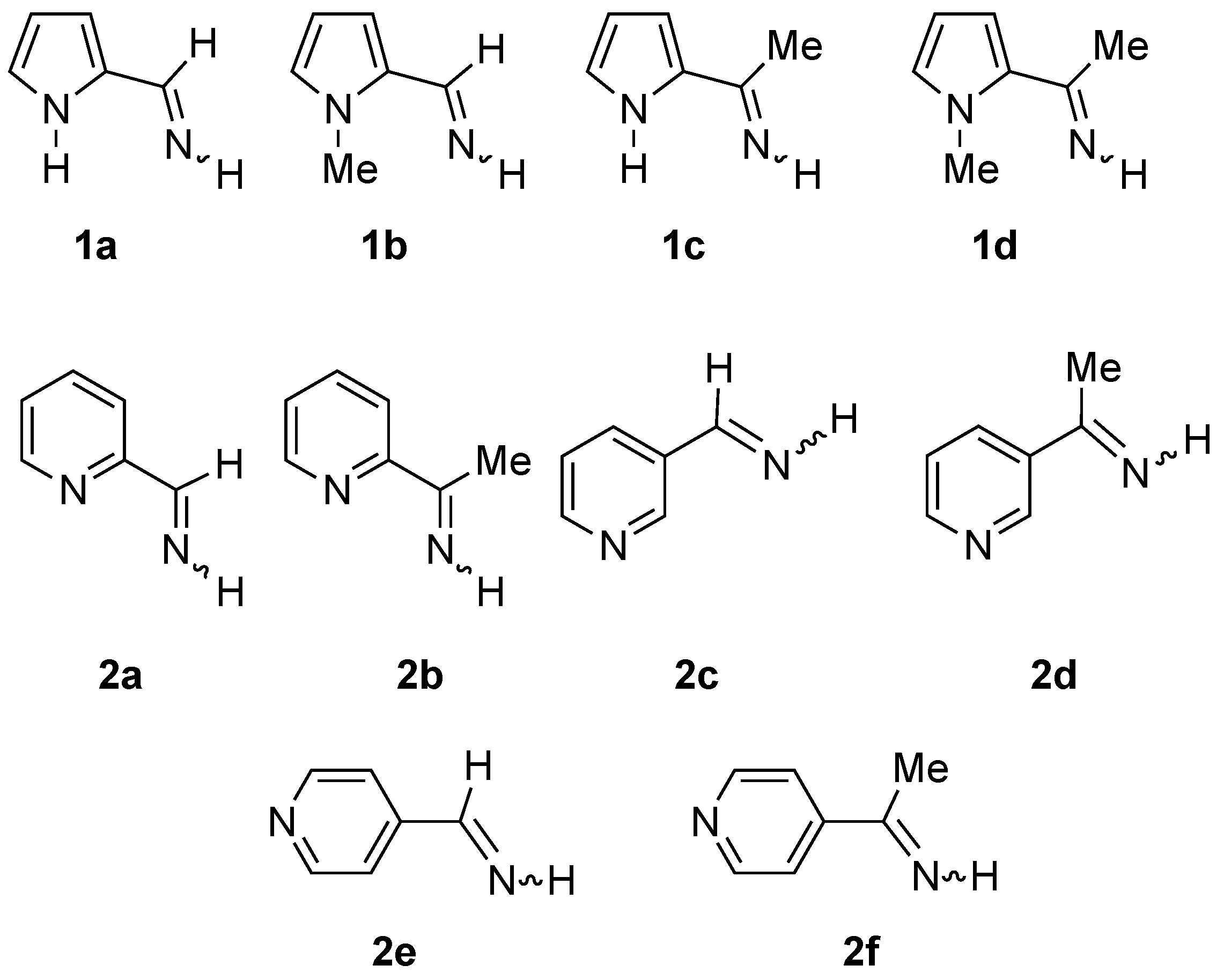




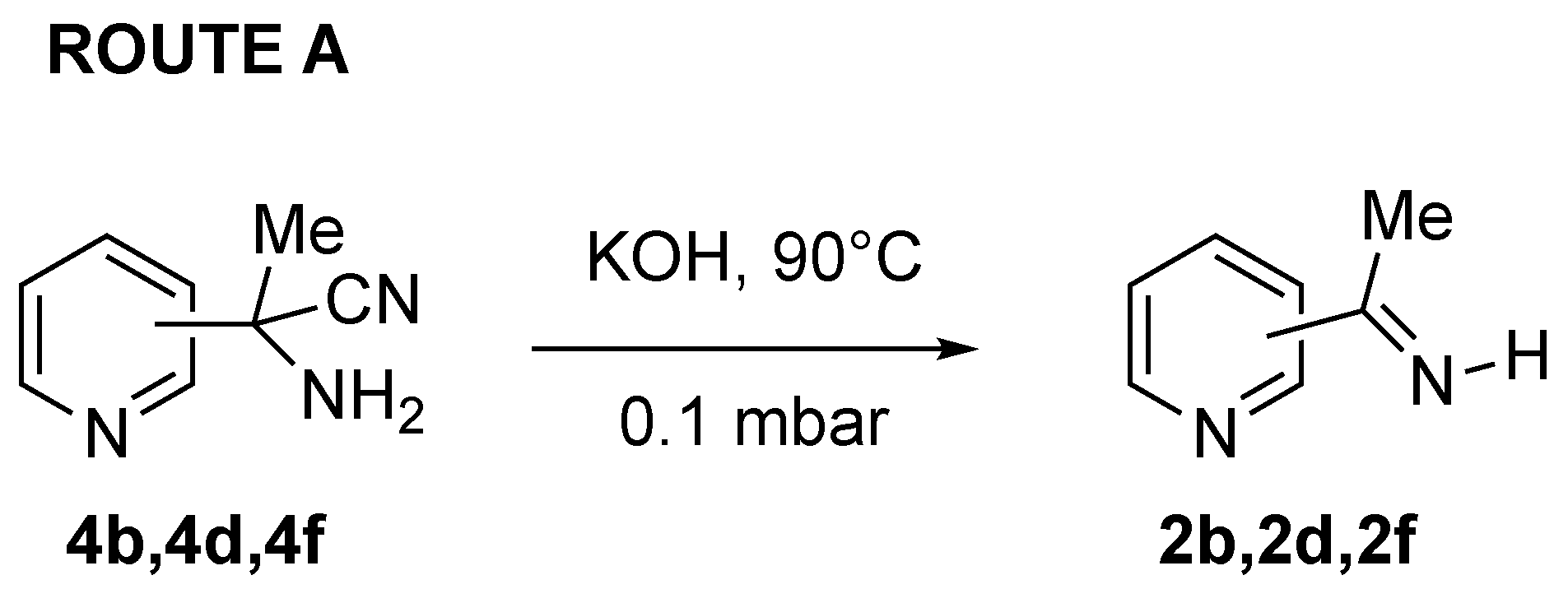
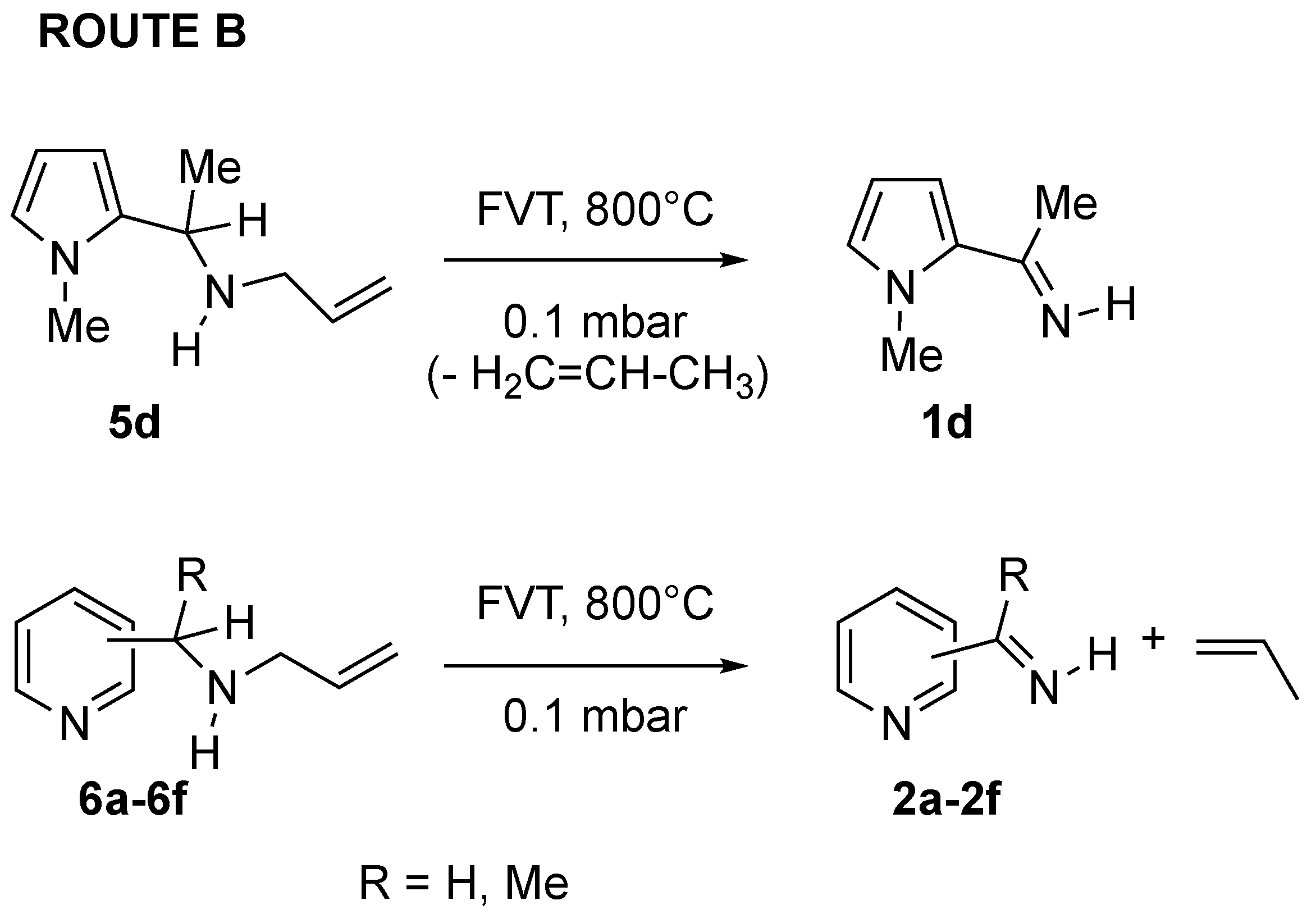
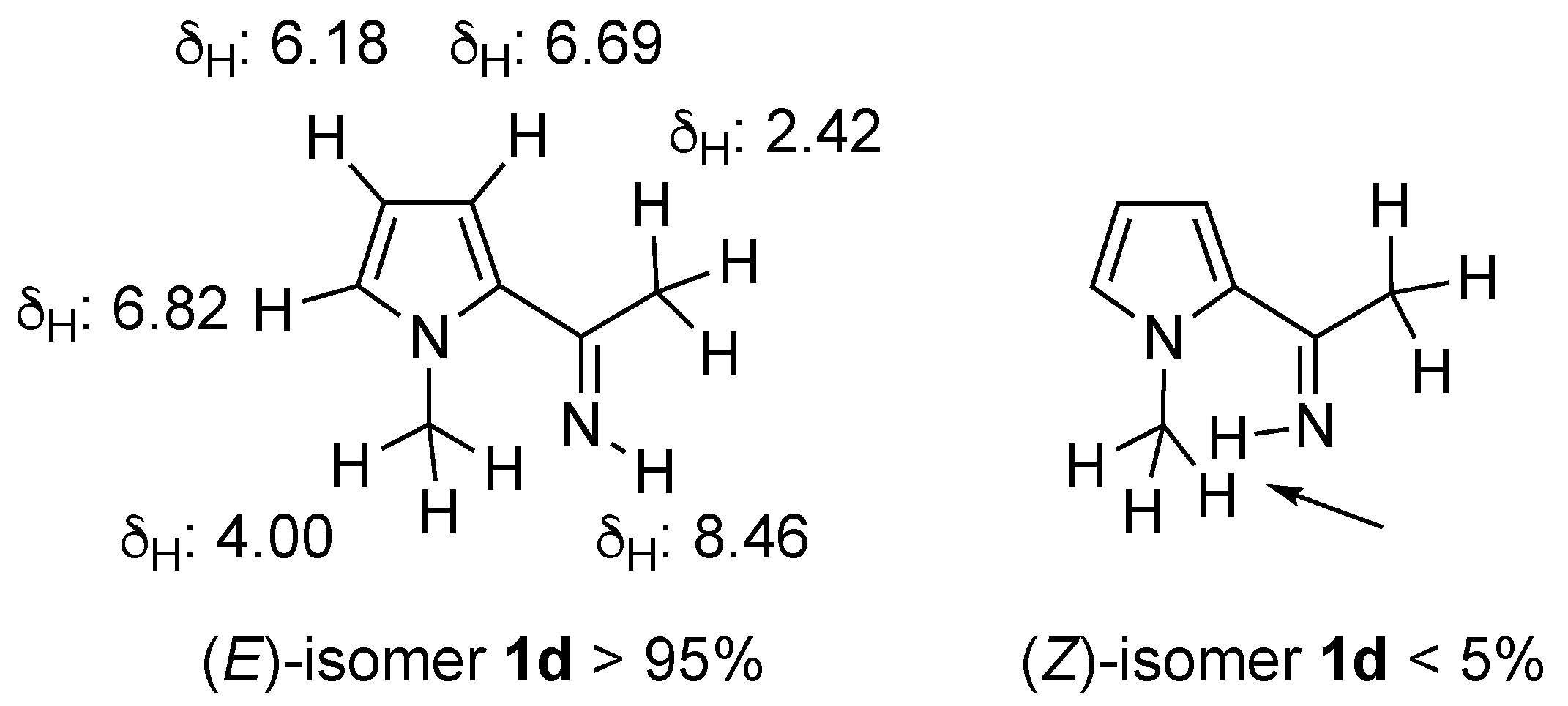
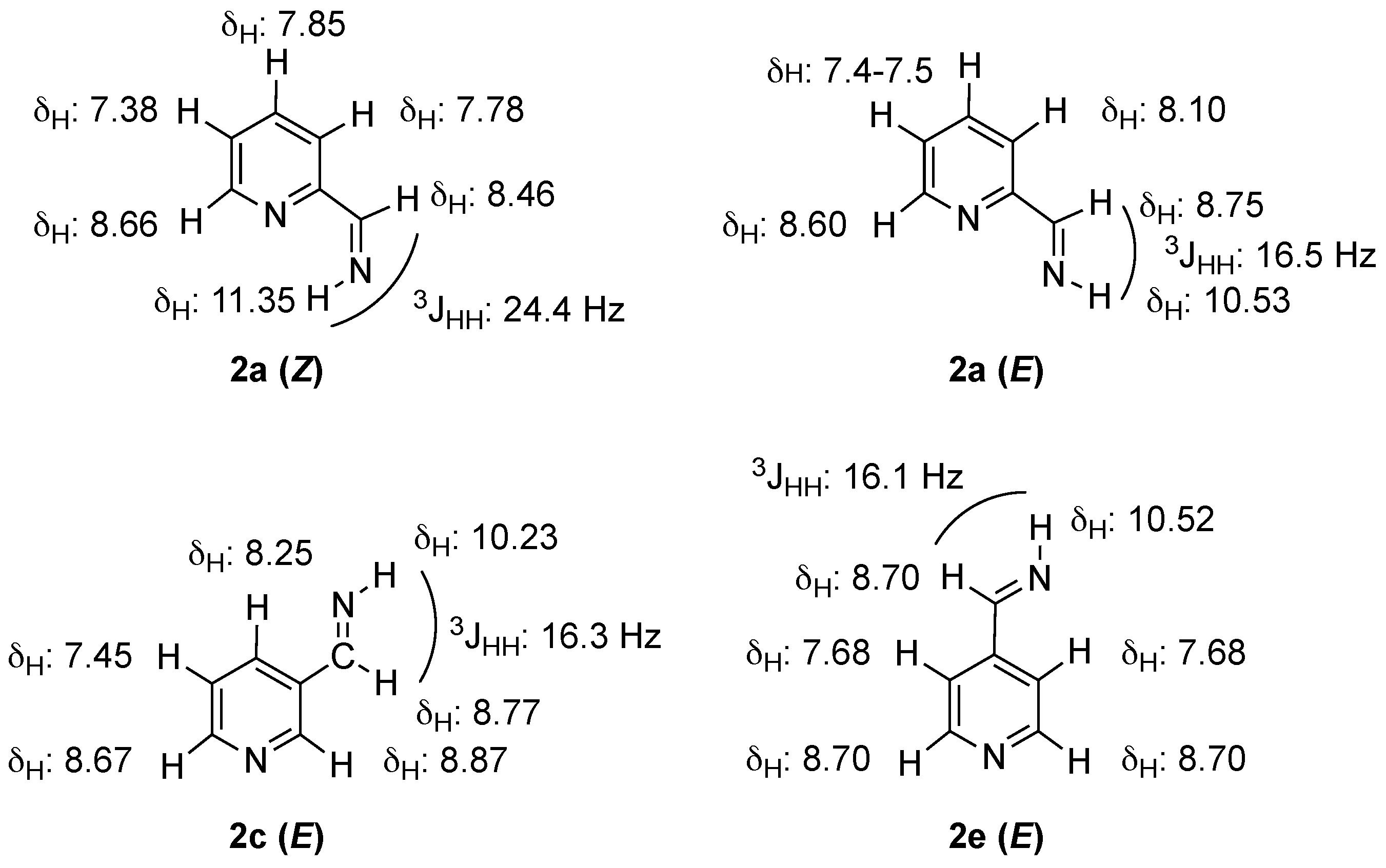



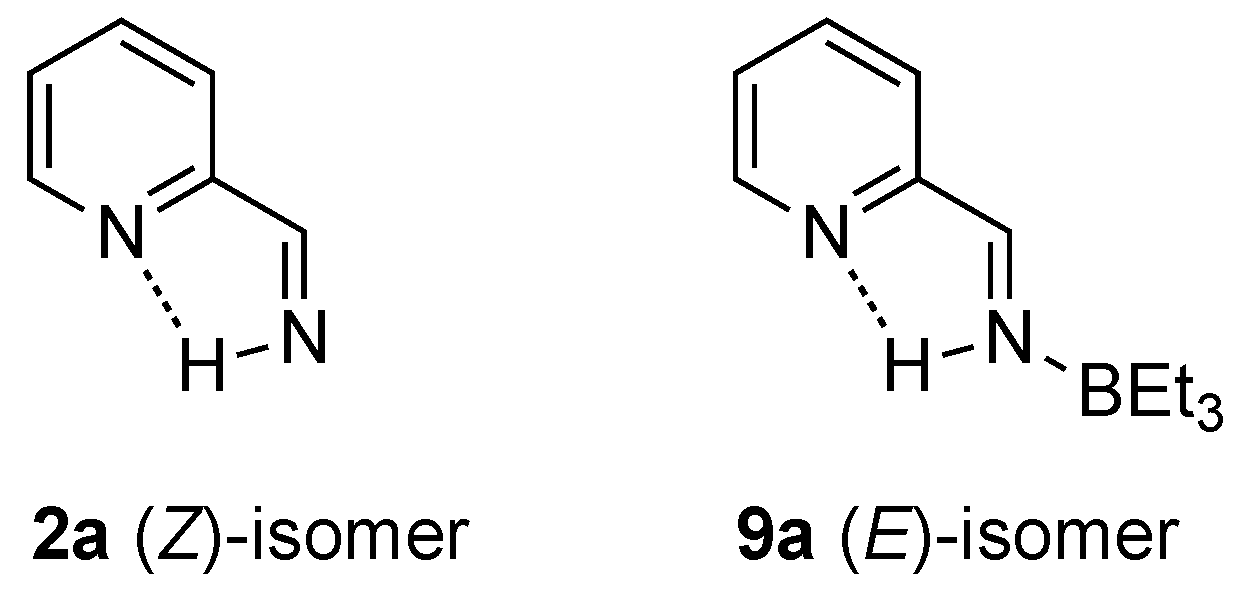
| Compound | 3a | 3b | 3c | 3d | 4a | 4b | 4c | 4d | 4e | 4f |
| Yield (%) | 65 | 70 | 0 | 0 | 82 | 90 | 80 | 89 | 90 | 70 |
| Compound | 5a | 5b | 5c | 5d | 6a | 6b | 6c | 6d | 6e | 6f |
| Yield (%) | 92 | 92 | 90 | 91 | 93 | 93 | 93 | 90 | 89 | 93 |
| Compound | 1a | 1b | 2a | 2b | 2c | 2d | 2e | 2f |
| Yield (%) | 0 | 0 | 0 | 75 | 0 | 72 | 0 | 70 |
| Compound | 1a | 1b | 1c | 1d | 2a | 2b | 2c | 2d | 2e | 2f |
| Yield (%) | 0 | traces? | traces? | 80 | 23 | 80 | 76 | 77 | 80 | 80 |
Disclaimer/Publisher’s Note: The statements, opinions and data contained in all publications are solely those of the individual author(s) and contributor(s) and not of MDPI and/or the editor(s). MDPI and/or the editor(s) disclaim responsibility for any injury to people or property resulting from any ideas, methods, instructions or products referred to in the content. |
© 2025 by the authors. Licensee MDPI, Basel, Switzerland. This article is an open access article distributed under the terms and conditions of the Creative Commons Attribution (CC BY) license (https://creativecommons.org/licenses/by/4.0/).
Share and Cite
Kpoezoun, A.; Baba, G.; Guillemin, J.-C. Primary Pyrrolimines and Pyridinimines. Molecules 2025, 30, 1239. https://doi.org/10.3390/molecules30061239
Kpoezoun A, Baba G, Guillemin J-C. Primary Pyrrolimines and Pyridinimines. Molecules. 2025; 30(6):1239. https://doi.org/10.3390/molecules30061239
Chicago/Turabian StyleKpoezoun, Amavi, Gnon Baba, and Jean-Claude Guillemin. 2025. "Primary Pyrrolimines and Pyridinimines" Molecules 30, no. 6: 1239. https://doi.org/10.3390/molecules30061239
APA StyleKpoezoun, A., Baba, G., & Guillemin, J.-C. (2025). Primary Pyrrolimines and Pyridinimines. Molecules, 30(6), 1239. https://doi.org/10.3390/molecules30061239







